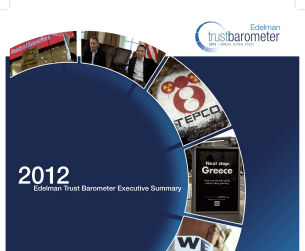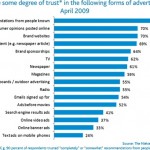
After reading Michael Chan’s post on the upside of ordinary and obvious advertising, I was reminded of the myriad of confusing pharmaceutical ads that I’ve seen.
Thinking of TV ads for new drugs, I instantly see images of serene couples smiling happily at their children, or young women looking out to sea. I remember that on several occasions, I would wonder what the ad was exactly for, never mind its side effects or how to go about acquiring the medication (whether over the counter or through a doctor’s prescription).
I was surprised to find many studies done on this topic, many of which are noted by journalist Kate Pickert in her article for Time Magazine. It seems that perhaps, the sort of confusion I feel when seeing these ads is just that which the pharmaceuticals want viewers to feel. Tactics such as faster narration when listing the side effects or using distracting images to draw our attention are some of the many used to detract from the underlying message.
Tying it back to Michael’s post, I believe that these types of ads are just those that do require more ordinary and obvious depictions. It is unethical to try to confuse viewers on the possible negatives of a new drug or other important information, and it is not beneficial either to those who would have otherwise benefited from the new drug.

In response to Amanda Lai’s Post on honest marketing, I decided to do a post on Domino’s Pizza Turnaround campaign in 2009.
In this innovative campaign, Domino’s featured negative comments from its harsh critics, such as how Domino’s “crust tastes like cardboard” and its “sauce is like ketchup“. Domino’s then went on to show how they transformed their pizzas.
Central to the Domino’s Pizza Turnaround campaign was a mini-documentary which showed the re-making of Domino’s pizzas from the dough to the garnish on the crust. The documentary has garnered nearly 900,000 views on YouTube since its inception and has been an excellent way for fans and non-fans of Domino’s to post their comments.
Though risky, I believe that the Domino’s move was extremely effective. Not only was it original, it rebuilt the trust in the Domino’s name that had been so mercilessly sullied by its many harsh critics. The Turnaround campaign was also effective in portraying Domino’s as quirky, transparent and dedicated to serving the best pizza to delight its customers.

It is always interesting to find research data that connects with course concepts and textbook readings. Take for example, David Armano’s blog, “Logic + Emotion” http://darmano.typepad.com/. In a recent post, he detailed the findings of a study by Edelman Insight that quantified the trust customers place on different sources of information. The 2012 Edelman Trust Barometer showed some striking changes from last year’s results:

Increased scepticism towards institutions – Trust in government officials or regulators and CEO’s faced double-digit decreases from last year.
![]()
Increased trust in “a person like yourself” – Trust in 3rd party individuals increased by a stunning 22% from 2011.
With these findings at hand, what can companies do to take advantage of this new information? Armano suggests that companies “share the stage with ‘regular’ people who have a voice via a variety of social channels.” This is where textbook concepts enrich real-life examples – namely customer-managed relationships and consumer-generated marketing. Companies should make platforms available, such as Blogger, Twitter and Facebook, through which consumers can actively interact and share their views with others. Allowing consumers to “like”, “tweet” or blog about the company’s brand can spark consumer-generated marketing which, according to research (see above) is increasingly appealing to and trusted by consumers.
Monitoring consumer-generated marketing seems almost impossible as consumer comments and ratings are uncensored over the web. However, this may prove to be beneficial to the company by allowing the company to focus on building value and satisfying or delighting customers. These customers in turn will be the channel through which the brand is promoted by advocating the company`s products on the platforms available online.
 Even with the heaps of money that American firms spend on TV ads, print ads and such each year (in 2010 American firms spent more than $94 billion in 3 quarters! See the article here http://www.good.is/post/transparency-which-companies-spent-the-most-on-advertising-last-year/), nothing beats word of mouth advertising.
Even with the heaps of money that American firms spend on TV ads, print ads and such each year (in 2010 American firms spent more than $94 billion in 3 quarters! See the article here http://www.good.is/post/transparency-which-companies-spent-the-most-on-advertising-last-year/), nothing beats word of mouth advertising.
People are becoming savvier consumers and are tightening their wallets in the midst of the financial uncertainty. Do such forms of traditional advertising really convince a substantial number to go out and purchase their product? These days, we are so constantly bombarded by the ads we see each day that we tend to tune them out. How many advertisements do we actually take note of?
Recently I’ve been shopping around for a new laptop. I was seriously considering a particular brand but a close friend of mine, who owned one previously, strongly recommended against it. This brand was instantly crossed off the list for me. Any previous advertisement I had seen, the beautiful design of their stores and just the product itself made no difference at all when a trusted friend had so much harsh criticism for them.
On the other end, nearly a dozen friends recommended Apple laptops. They were not just Apple advocates – they were Apple fanatics! Listening to them, one can tell Apple has really worked hard to build their customer equity. I was quite easily swayed to purchase one.
 And that’s not just me. In a survey with over 25,000 respondents, 90% stated that they had some degree of trust in recommendations from people known. That’s 28% more than TV advertisements!
And that’s not just me. In a survey with over 25,000 respondents, 90% stated that they had some degree of trust in recommendations from people known. That’s 28% more than TV advertisements!
http://www.designinc.co.uk/design-blog/advertising-and-consumer-trust/
In short, yes, raising awareness of your product is vital, but even more so is to deliver value, not just in flashy advertisements or fancy packaging but in the product itself and in delivering customer service. Satisfied customers go a long way in bringing more satisfied customers.





